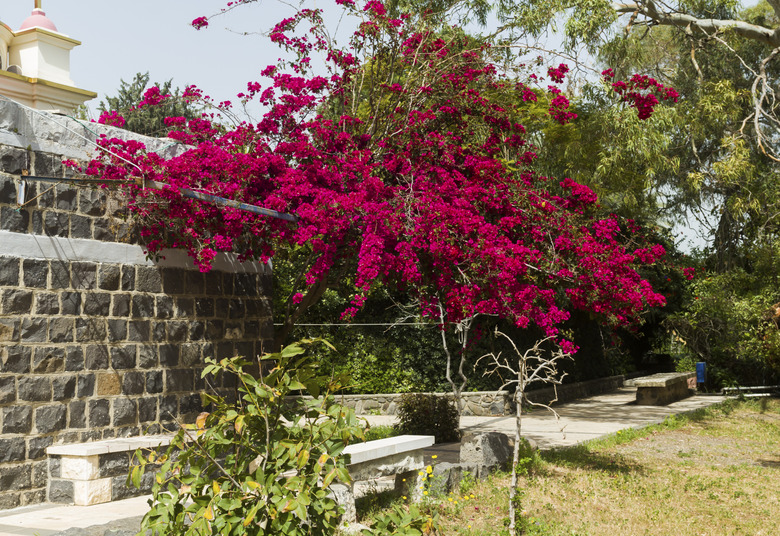Bougainvillea Trees
Bougainvillea (_Bougainvillea spp._) is a tropical plant that naturally assumes a climbing or trailing form, and it does well when allowed to climb up and over a trellis or fence. With proper care, however, it can also be trained to take on the form of a small tree.
Bougainvillea (Bougainvillea spp.) is a tropical plant that naturally assumes a climbing or trailing form, and it does well when allowed to climb up and over a trellis or fence. With proper care, however, it can also be trained to take on the form of a small tree.
Bougainvillea Species
Bougainvillea is a shrubby vine native to South America. It's hardy in U.S. Department of Agriculture plant hardiness zones 9 to 11, so in the United States, it can only be grown in the ground in the warmer climates of the South and West. It can grow in a container in cooler climates if you bring it inside when temperatures fall.
The plants have woody stems with inch-long spines, and they produce small white flowers surrounded by large, colorful bracts — the part of the bloom that gives the plant its ornamental value.
Growth Habits
Although bougainvillea is usually thought of as a vine, its natural growth habit is that of a rambling shrub. It will climb if given the opportunity, but will stay shrubby or grow along the ground if left alone.
- Bougainvillea (Bougainvillea spp.) Although bougainvillea is usually thought of as a vine, its natural growth habit is that of a rambling shrub.
- It will climb if given the opportunity, but will stay shrubby or grow along the ground if left alone.
Bougainvillea is a vigorous grower, especially when planted in the ground, and regular pruning is essential to keep it trained in tree form. Pruning also helps the plant bloom more prolifically, because blooming occurs on new growth; prune branches to 18 or 20 inches in length to encourage blooms. Sterilize your pruning tools with a household cleaner before use.
Tree Bougainvillea
The University of Florida's Lee County Extension Service notes that there are some rare examples of bougainvillea growing naturally in tree form in Florida and in other parts of the South. It is unclear, however, which species these specimens belong to; they may be the species commonly called tree bougainvillea (Bougainvillea arborea) or a variety of Bougainvillea glabra.
These tree-like species have short trunks, and they usually lack spines. They grow best in dry areas with full sun exposure.
Training Bougainvillea
To train bougainvillea into tree form, plant a young vine next to a 3-foot-high stake, getting it as close to the stake as possible. Wrap the stem of the vine around the stake, holding it gently in place with a soft plant tie, and prune away any side branches. As the plant grows, remove any side shoots or shoots above the stake that don't conform to the desired shape. The trained stem will eventually form a woody trunk, and the branches above the trunk will likely take on a weeping form.
- Bougainvillea is a vigorous grower, especially when planted in the ground, and regular pruning is essential to keep it trained in tree form.
- Pruning also helps the plant bloom more prolifically, because blooming occurs on new growth; prune branches to 18 or 20 inches in length to encourage blooms.
